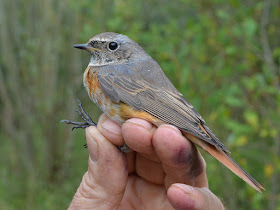Highlights and observations of note were as follows:
- A Willow Warbler was ringed and is a fairly late record but still well short of the latest for the site which was on 23/10/2014.
- Goldcrests just managed to scrape into double figures for the first time this month with 10 ringed but it still looks like the UK population has taken a tumble as double figure totals should be the norm for much of September. Interestingly, 9 of the 10 Goldcrests were females.
- This was the first session of the autumn without a Blackcap being ringed and none were seen or even heard.
- Tits are starting to show signs of getting itchy feet with Coal Tits becoming much more vocal and flighty. While I sure some do move others may just go through the motions and turn back or only go a relatively short distance.
- Great Tits also showed a sex bias today with the 7 ringed all being females.
- There was next to no visible migration despite the clear conditions and fairly light breeze with only a handful of Meadow Pipits, a few Skylarks, 4 Reed Buntings, 2 Siskins and 3 Redpolls being noted.
Ringing totals for 25/09/2018 were: Coal Tit 3; Blue Tit 4; Great Tit 7; Willow Warbler 1; Chiffchaff 4; Goldcrest 10; Chaffinch 2; Yellowhammer 2; Reed Bunting 1.
 |
| Willow Warbler 25/09/2018 |

















